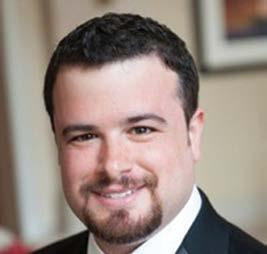
4 minute read
The Ever Present Quest to Build Community
The Ever Present Quest to Build Community
Zachary Benjamin | Chief Executive Officer, Jewish Long Beach
Advertisement
College, for me, was an era of social and intellectual growth, occasional awkwardness, trial, and frequent error. I entered Northwestern University as a “serial doer,” seeking my academic and extracurricular niches in an eclectic array of pursuits, from serving as a sports writer for the Daily Northwestern and joining the ski team, to pledging the Alpha Epsilon Pi fraternity and taking up a minor in Chinese language. Ultimately, I found my primary extracurricular bliss as a member of the Associated Student Government (ASG), where I eventually ascended to the role of parliamentarian my senior year.
Throughout my time as a member of that deliberative body, the ASG Senate and Executive Board perpetually agonized over how we as a student body might achieve the ethereal concept of “community” and provide a meaningful communal experience for the university’s intellectually and culturally diverse student body. Whether approving funding proposals for student organizations or debating the merits of adding a nominal student activities fee to tuition, each of the hundreds of resolutions, requests, and deliberations in which I participated ultimately focused on how we might create a more dynamic, engaged, committed student community.
Nearly 20 years later, almost two decades into a public-sector career and seven years into my journey as a Jewish communal executive, the concept of community still sits at the heart of my work and that of our Jewish agencies, congregations, and organizations. “Building community” remains the Melvillian white whale for our professional and volunteer sector—an ideal that we chase, the methods for achieving we consistently improve, and yet the quest for which remains perpetually, if ever more slightly, elusive.
The population Jewish agencies serve is not necessarily a diverse community of students, but rather an even more complex and challenging constituency of Jewish people and institutions. However, the goals of Jewish communal work are, in many respects, identical to those of the student government of my past life: to identify those threads of common ground that bind us as one people with unique and varied individual identities, and to create opportunities for the broadest possible cross section of that population to find connection and comradery. Just as ASG reviewed and approved university funding for community-building activities, so Jewish Long Beach’s Planning and Grants Committee considers and approves funding proposals from a wide variety of Jewish communal organizations with the goal of building connections between us as humans and as Jews. Just as ASG ultimately approved a student activities fee that availed students of access to all university sporting events, so the Alpert JCC occasionally must consider levying or increasing fees when it enhances opportunities to build community among us.
As Jews, we refer to ourselves rightly as a nation. Indeed, we are a socio-cultural group that, despite deeply divergent religious practices, political perspectives, and personal backgrounds, nonetheless share inherited traits, traumas, and rituals that bind us as a people. The historian Benedict Anderson, in his seminal book “Imagined Communities”, observes that, “The nation is always conceived as a deep, horizontal comradeship. Ultimately, it is this fraternity that makes it possible…for so many millions of people [to sacrifice and care about] such…imaginings.”
The reality is that the pursuit of community is a logarithmic scale. We approach our goals as we perfect the equation for achieving them, but by its very nature, the destination is unreachable. Human nature and habits evolve. Environmental factors cause frequent shifts in how, and with whom, we seek community.
Last month, Jewish Long Beach and the Alpert JCC hosted our first-ever “9th Night” holiday celebration, a gathering at the Long Beach Beer Lab for the “young and young at heart” that attracted hundreds of new faces and old friends who, in every regard, represented the layers of diversity that characterizes the Jewish people and the broad Long Beach-area community. Tzit tzit-adorned Chabad rabbis mingled with tattooed college students, octogenarians with 20-somethings, political conservatives with dedicated progressives. It occurred to me that I was witnessing perhaps the purest illustration of community that I had yet observed in a Jewish setting or any other.
Observant Jews believe that perfection is only achievable by G-d, and indeed, perfection does appear out of human reach. However, if we as institutions and individuals continue to seek the common ground that we as Jews, as members of the Long Beach and West Orange County communities, and as human beings share, we will achieve increasingly frequent moments of connection, community, and shared joy.










